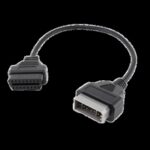Understanding your vehicle’s health is becoming increasingly accessible, and at the heart of this revolution is the OBD2 (On-Board Diagnostics) system. Modern cars are equipped with sophisticated computer systems to monitor everything from engine performance to emissions. OBD2 provides a standardized way to access this wealth of data, and connecting your Laptop To Obd2 opens up a powerful world of vehicle diagnostics and insights.
Decoding OBD2: Your Car’s Diagnostic Center
OBD2 is essentially your car’s internal health monitoring system. Its primary purpose is to track emissions and other critical parameters. By monitoring various sensors throughout your vehicle, OBD2 can detect potential issues early, often before they escalate into major problems. This early detection capability is a significant benefit, saving car owners from costly repairs and ensuring optimal vehicle performance.
When OBD2 detects a fault, it logs a diagnostic trouble code (DTC) and often illuminates the “check engine” light. Beyond just error codes, OBD2 systems also provide real-time data from your vehicle’s sensors. This live data stream includes crucial information such as engine speed (RPM), vehicle speed, engine temperature, fuel consumption, and much more. This rich data allows for in-depth analysis of your vehicle’s operation and performance.
Unlocking OBD2 Data with Your Laptop
To access the valuable information within your OBD2 system, you need a scan tool. While stand-alone scan tools are available, connecting your laptop to OBD2 offers a more versatile and powerful diagnostic solution. This approach utilizes the processing power and user interface of your laptop to provide advanced diagnostic capabilities.
Why Choose a Laptop OBD2 Scanner?
Opting for a laptop to OBD2 setup offers several key advantages over traditional, stand-alone scan tools:
- Enhanced Functionality: Laptop-based systems are not limited by the processing power or screen size of handheld devices. They can run sophisticated diagnostic software, perform in-depth data analysis, and offer advanced features like data logging and graphing.
- Software Upgradeability: Laptop OBD2 software is easily upgradeable, ensuring you always have the latest features, vehicle coverage, and diagnostic capabilities. Stand-alone tools often become outdated quickly and are expensive or impossible to upgrade.
- Cost-Effectiveness: In many cases, a laptop to OBD2 adapter combined with software can be more cost-effective than purchasing a high-end stand-alone scan tool with comparable features. You leverage the computer you already own.
- User-Friendly Interface: Laptop software typically offers a more intuitive and user-friendly interface compared to the often-clunky interfaces of handheld scanners. The larger screen and familiar operating systems make navigation and data interpretation much easier.
- Versatility and Portability: Your laptop is already a multi-purpose device. Adding OBD2 functionality through an adapter and software enhances its utility, turning it into a powerful automotive diagnostic tool that you can easily take with you.
Connecting Your Laptop to Your Car’s OBD2 Port
Connecting your laptop to OBD2 is a straightforward process requiring just a few key components:
- OBD2 Adapter: This is the hardware interface that plugs into your car’s OBD2 port (typically located under the dashboard on the driver’s side). OBD2 adapters are available in various connection types such as USB, Bluetooth, and Wi-Fi to connect to your laptop.
- OBD2 Software: You’ll need diagnostic software installed on your laptop. Many software options are available, ranging from free basic programs to professional-grade diagnostic suites. The software communicates with the OBD2 adapter to retrieve and interpret data from your vehicle’s computer.
Once you have these components, the process generally involves:
- Installing the OBD2 software on your laptop.
- Connecting the OBD2 adapter to your car’s OBD2 port.
- Establishing a connection between the adapter and your laptop (via USB, Bluetooth, or Wi-Fi, depending on the adapter type).
- Launching the OBD2 software and initiating a vehicle scan or data reading session.
Conclusion: Empowering Vehicle Diagnostics with Your Laptop
Utilizing your laptop to OBD2 represents a smart and effective approach to vehicle diagnostics. It provides access to a wealth of information about your car’s performance and health, empowering you to understand and address potential issues proactively. By choosing a laptop to OBD2 setup, you gain a powerful, flexible, and cost-effective tool for automotive diagnostics, putting you firmly in control of your vehicle’s maintenance and care.
